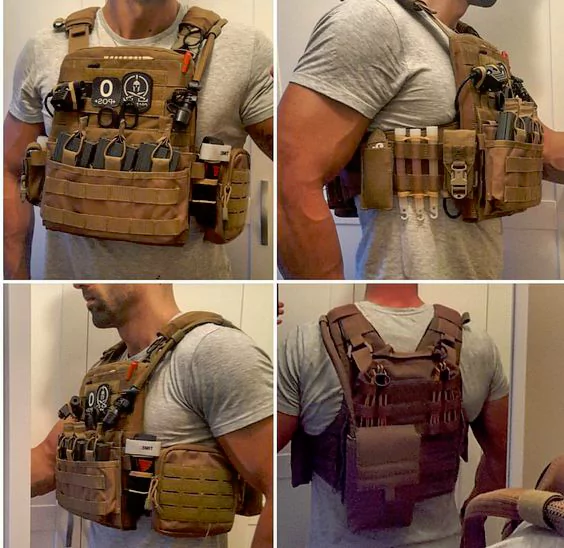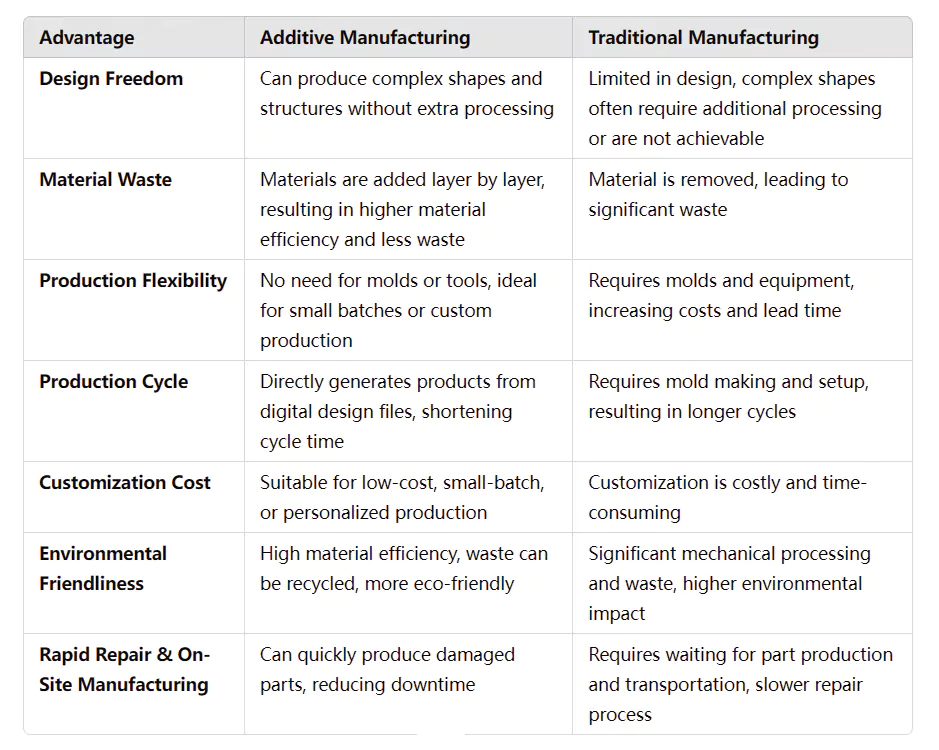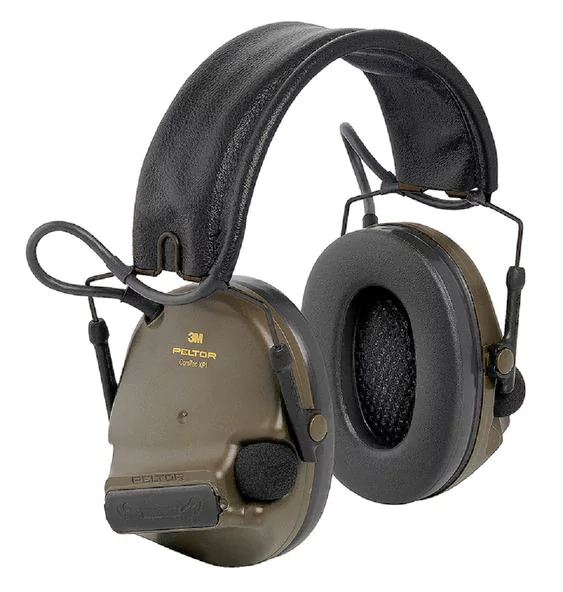In modern warfare, military equipment’s rapid repair capability is crucial to safeguarding troops’ combat effectiveness. Additive manufacturing technology, with its flexibility and efficiency, is providing a new solution for this.
This paper discusses the current use of additive manufacturing for rapid military equipment repair. It covers technical advantages, and challenges, and offers strategies and recommendations to promote further development.

Overview of additive manufacturing technology
1. Definition and development of additive manufacturing technology
Additive manufacturing, or 3D printing, builds three-dimensional objects by adding materials layer by layer. First proposed in the early 1980s, this technology has quickly evolved from concept to practical use.
The main advantage of this technology is its flexibility and customization, which improves manufacturing efficiency. It is especially useful for rapidly producing parts with complex shapes that are difficult to make with traditional methods.
As technology advances, its applications continue to grow, especially in the military. Additive manufacturing shows great potential in military equipment repair. It reduces production costs and increases efficiency, making it a vital tool for modern warfare.
2. Military application potential of additive manufacturing technology
Additive manufacturing technology offers great potential for military equipment repair. It can rapidly produce complex parts. Traditional methods struggle with meeting military equipment’s complex structure needs, while additive manufacturing excels in this area. For example, it can quickly customize and produce accessories or protective equipment for weapons, ensuring they meet battlefield requirements.
Additive manufacturing also boosts repair efficiency. Unlike traditional methods that require waiting for parts to be shipped, this technology produces replacement parts on-site or at the base. It reduces downtime, ensuring combat equipment stays operational.
In addition, additive manufacturing technology also excels in reducing costs and improving material utilization. By optimizing design and reducing material waste, additive manufacturing allows military budgets to be effectively controlled.
Comparison of additive manufacturing and traditional manufacturing technologies
Table 1 Comparison of Additive Manufacturing Technology with Traditional Manufacturing Technology

Nonetheless, additive manufacturing technologies have limitations in some areas. For example, when manufacturing large equipment or high-strength, high-temperature-resistant material parts, traditional technology still seems more mature and reliable. Manufacturing technology in the material properties of the instability and complexity of post-processing also faces challenges.
The application of additive manufacturing technology in the rapid repair of military equipment
1. Application of additive manufacturing in the repair of equipment of various military services
Additive manufacturing technology has delivered impressive results in military equipment repair.
In the Army, it rapidly repairs key components of ground equipment, like tanks and armored vehicles. Troops can quickly 3D print replacements for battlefield-damaged parts. This reduces repair time, enhancing mobility and operational efficiency.
In the Navy, additive manufacturing is crucial for producing complex parts, such as propellers and valves. This reduces delays from waiting for parts and boosts ship readiness.
In the Air Force, additive manufacturing speeds up aircraft maintenance. It allows rapid production of critical components, like engines and landing gear, improving maintenance efficiency and aircraft stability.
2. The technical advantages of additive manufacturing technology
Additive manufacturing technology has shown many technical advantages in the rapid repair of military equipment:
(1) highly flexible and customized
Additive manufacturing quickly designs and produces customized parts based on military equipment needs. Unlike traditional methods, it skips complex molds or equipment adjustments. The process directly uses digital models to create required components, adapting to various repair needs and operational environments. It offers personalized solutions.
(2) Rapid response and short cycle time
In military operations, quickly repairing equipment is critical. Additive manufacturing enables rapid production and efficient mass repairs. On the battlefield or in remote locations, traditional manufacturing and transport can take weeks. Additive manufacturing, however, allows on-site production through digital design, quickly restoring equipment functionality and reducing downtime.
(3) Production capacity for complex parts
Additive manufacturing produces complex shapes and structures, especially internal channels, grid structures, and other difficult designs. Many military parts, such as engine components and body frames, require complex geometries. Additive manufacturing builds these parts layer by layer, making these designs easier to achieve.

(4) Reduce material waste, improve material utilization rate
Traditional manufacturing methods often use the “material reduction” approach, greatly reducing the material, and resulting in waste. Additive manufacturing reduces material waste by adding materials layer by layer, using only the needed parts. This improves resource utilization and is crucial for the army’s logistics and material management.
(5) Adaptation to small batches and urgent repair needs
In the battlefield environment, the advantages of additive manufacturing are extremely prominent when equipment repair is urgently needed. Traditional manufacturing struggles with small batches or urgent repairs. Additive manufacturing provides quick solutions, saving time and reducing production and transportation costs.
(6) Reduce manufacturing costs
Additive manufacturing in small batch production and customized production in the advantage of the cost is extremely obvious. Traditional manufacturing techniques usually require expensive molds and equipment, while additive manufacturing requires these initial tools, greatly reducing production and maintenance costs, especially for emergency repair and custom parts production.
(7) Sustainability and environmental friendliness
Additive manufacturing technology reduces the generation of substitution by precisely controlling the use of materials. Many additive manufacturing materials can be reused, which for the military not only reduces the cost of alternative disposal but also helps to improve the sustainability of equipment.
(8) Remote and on-site manufacturing capabilities
Additive manufacturing allows on-site equipment repairs in remote areas while waiting for parts to be shipped. This flexibility and speed make it ideal for military logistics and battlefield environments, ensuring equipment is combat-ready quickly.
Challenges of Additive Manufacturing Technology
The application of Additive Manufacturing (AM) technology in the rapid repair of military equipment has great potential to enable the rapid production and customization of parts, but the challenges it faces should not be ignored. Here are a few specific challenges:
1. Material performance issues
The variety of materials available for additive manufacturing is relatively small, and the performance of many materials has not yet reached the high standards required for military equipment. For example:
(1) Insufficient strength and toughness:
Some additive manufacturing materials have low strength and toughness and cannot withstand the extreme environments or high-load operations often faced in military equipment. For example, parts on airplanes, tanks, or ships often need to have high strength, high wear resistance, and corrosion resistance.
(2) Poor heat resistance:
Engine parts, heat exchangers, and other military equipment parts often need to withstand high temperatures. However, additive manufacturing materials still have performance limitations in this area. These limitations may cause parts to lack thermal stability in high-temperature environments, affecting equipment performance.
(3) Fatigue life problems:
Some additively manufactured materials may exhibit poor fatigue life under repeated loads, especially in the use of mechanical parts or structural components. This may lead to cracks or fractures in the parts during long-term use, thus affecting the reliability of the equipment.
2. Accuracy control problems
In additive manufacturing, thermal effects, material shrinkage, and interlayer bonding often reduce dimensional accuracy and surface quality, failing to meet the high standards required for military equipment.
(1) Thermal effects and deformation:
In additive manufacturing, the heat source melts and builds up material, often causing high local temperatures and thermal deformation. For example, uneven cooling and temperature distribution in metal materials can cause warping, cracking, or dimensional errors on part surfaces.
(2) Surface roughness:
Additive manufacturing’s layered nature often results in rough surfaces, particularly in complex or narrow parts. This can impact the surface quality, making it difficult to meet the high finish or abrasion resistance required by military equipment. Excessive surface roughness may affect the assembly accuracy of the part or even the service life of the part.

3. Post-processing problems
The post-processing of additive manufacturing, including heat treatment, surface treatment, and removal of support structures, is usually more complex and time-consuming than traditional manufacturing methods, posing certain challenges:
(1) Heat treatment difficulty:
Additive manufacturing materials often need heat treatment after molding to improve strength, toughness, and wear resistance. However, due to the differences in material structure compared to traditional methods, heat treatment can cause stress concentrations, deformation, or other issues. This may result in inhomogeneous material properties.
(2) Surface treatment:
Since the surface of additively manufactured parts is generally rougher, additional surface treatment, such as spraying, grinding, or plating, is required during the repair process. This tends to increase production costs and lengthen the production cycle due to the complexity and difficulty of the surface treatment process.
(3) Removal of support structures:
Additively manufactured parts often need support structures during printing to maintain their shape. However, these structures must be removed later. Removing the support requires care to avoid damaging the part. After removal, the part may need further cleaning and polishing, increasing post-processing time and cost.
4. Production Costs and Lead Times
Additive manufacturing can shorten production cycles, but its complexity and post-processing requirements may raise costs. Compared to traditional methods, it often needs more human intervention and technical support, especially for high-quality parts. The costs for accuracy and post-processing are also higher. Additionally, the evolving supply chain for additive materials means certain high-performance materials are more expensive, further increasing production costs.
5. Durability and reliability of equipment
Additive manufacturing can enable the repair and customization of complex shapes. However, its long-term reliability in high-risk environments, such as military equipment, remains a concern. Under extreme conditions—like high temperature, pressure, corrosion, and wear—additively manufactured parts may not perform as reliably as traditionally made parts.
The development trend of additive manufacturing technology in the rapid repair of military equipment
As materials science and additive manufacturing technology progress, additive manufacturing will play a larger role in rapidly repairing military equipment. Ongoing research into new materials will address the performance limitations of current materials, providing higher-performance alternatives. At the same time, improvements in precision control and post-processing will enhance the quality and reliability of parts.
As additive manufacturing becomes more widespread, its costs will decrease. This will allow more military forces to adopt the technology for equipment repairs, boosting the combat and protection capabilities of troops.
Strategy and Recommendations
To fully utilize the potential of additive manufacturing technology in the rapid repair of military equipment, the following are some strategies and recommendations:
Table 2 Strategies and Recommendations

Conclusion
Additive manufacturing technology has great potential to improve military equipment repair. It can increase efficiency, reduce costs, and enhance part quality. Although challenges with material properties, accuracy, and processing exist, technology advancements will address these issues.
Through technical research, process optimization, and talent development, additive manufacturing will offer better support for rapid military repairs. This will enhance the combat and security capabilities of troops.
